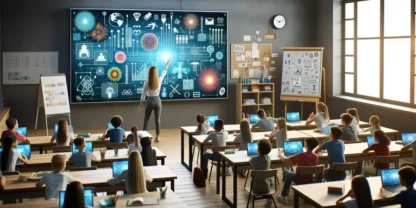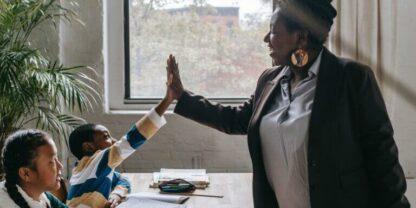Are your breakouts getting stale? Do you feel like you cycle through the same small group reading activities to the point where both you and your students are bored? It’s the start of a new year and that means new activities and exciting lesson plan opportunities. You can refresh your reading small groups to keep young learners engaged in the material.
Here are a few of our favorite reading comprehension lesson plans, games, and celebrations so your students can grow their critical thinking and deductive reasoning skills.
1. Create a Reading Comprehension Volcano
Reading a book is like unwrapping a present, the more you pull away ribbons and tissue paper, the better you can see the items inside. When your students first approach a story, they can guess what it is about (like shaking a present and lifting it up to see how heavy it is) but they will only develop a clearer understanding of the plot as they dive deeper into each paragraph or chapter.
Consider creating a comprehension volcano with each piece you read. The volcano has four parts:
- The Base: ask students what you think the story will be about. What will happen? What characters might play a role? There are no wrong answers here.
- The Middle: check-in halfway through the story. What is the book about? How will it end? What predictions were right?
- The Peak: review how the story ended and the overall plot. What did students think about the story? What could have happened differently?
- The Explosion: How can you apply the story to real life? What connections can you make to this story and others you have read? What do you want to learn next?
This activity teaches students to use contact clues before reading and to stop at different points to confirm their understanding and review the material.
2. Use Retelling Gloves
Retelling gloves can be used for fiction and nonfiction passages. Each finger has an element to the story (characters, setting, conflict, plot, etc.) and the palm and wrist also have open-ended questions for reflection. Ask students to put on the retelling glove and work through the ideas from the passage they read on each finger. This can help them think about each element and share their thoughts.
Check out the gloves by One Giggle At A Time to see an example of what they look like.
3. Flashlight Fridays
You might be surprised by how a small change in atmosphere can engage kids in reading groups. Turn off the lights on Friday afternoons and let students read by flashlight. They can even read on the floor with blankets and pillows if you have them. Turning off the lights can eliminate distractions and ensure each student is focused on the reading material.
For alternative options to Flashlight Friday, you can bring students to read outside on nice days or set up “read-ins” where students take over a different space each month (the principal’s office, the art room, another classroom) and read for 20 minutes without disruption.
4. Ask Small Groups to Create Retelling Bags
Retelling bags are a popular project for teachers, but you can modify these lesson plans for your new reading small groups. Students can work together to create a retelling bag, with each reader taking on different elements of the story. If your students read through a book over multiple days, they can even contribute items from home that are relevant to the plot and characters.
To make this project interactive, let your small groups swap bags after reading different books. Your students then become story sleuths to look at the clues in the bag and tell the story based on what items and descriptions are included. Your students might start laughing as their peers try to figure out what a banana, racecar, and a circus performer all have to do with the plot of a book.
5. Host a Character Meet and Greet
As your students engage with different stories throughout the year, they will pick some favorite characters and some least favorite ones. Invite students to dress up as their top heroes or villains for Book Character Day. You can build activities where the characters mingle together or host a meet and greet where students in other classrooms can talk to the characters and learn their stories.
This is a great way for your students to share the books they love with others – building a curiosity about the stories and a desire to read within their peers.
6. Comprehension Jenga
This activity is simple. All you need to create the lesson plan is a Jenga set and a marker. On each block, write an element of the story or a question to gauge the comprehension of your students. Set a timer for your reading small groups to review a passage or chapter and then let them play Jenga. Each student pulls out a block and answers a question on it until the whole stack falls. This is a good way to reward students for reading while ensuring they actually focused on the material.
7. Build Real-Life Connections
There are multiple reasons to form real-life connections with small group reading activities. The first reason is that it increases their interest in the story. Why should your students care about a character living through the Revolutionary War? Connections to real-life experiences make these characters real. Building real-life bonds in your reading small groups also helps with memory. Students are more likely to retain key information about the stories they engage with.
Consider building these connections through discussions in your small groups. Ask students to stop every few pages or paragraphs to build connections in real life. For example, if there is a character in the story named Matt, is he similar at all to a student named Matt in your classroom? Why or why not?
8. Tap Into Mirrors and Windows
One way to build real-life connections with students is to use Mirrors and Windows. A mirror is something students see themselves in. It is physical, cultural, social, or emotional representation. A window is a peek into another life or lived experience. Almost every character has mirrors and windows for your students.
For example, give the students in your reading small groups a book about a child in Belize attending their first day of school. Some of the mirrors that students see might include nerves on the first day and excitement about meeting new friends. However, there might be elements of the story that students have never experienced because they are unique to Belize. These are windows.
Utilize Different Small Group Reading Activities Each Week
Some students will connect with different projects and small group reading activities more than others. One student might love using retelling gloves while another enjoys playing Jenga. By switching out your lesson plans and bringing in new activities, you can keep your reading small groups fresh. Your students will want to read the material so they can participate in the activities that go with it.



